Are you running low on floor space? Don’t you worry, hanging succulents have come to rescue you. Hanging succulents are a popular, aesthetically pleasing plant choice that you can pot both indoors and outdoors.
This article will equip you with the necessary knowledge and the right tools to buy and care for your first succulent plant.
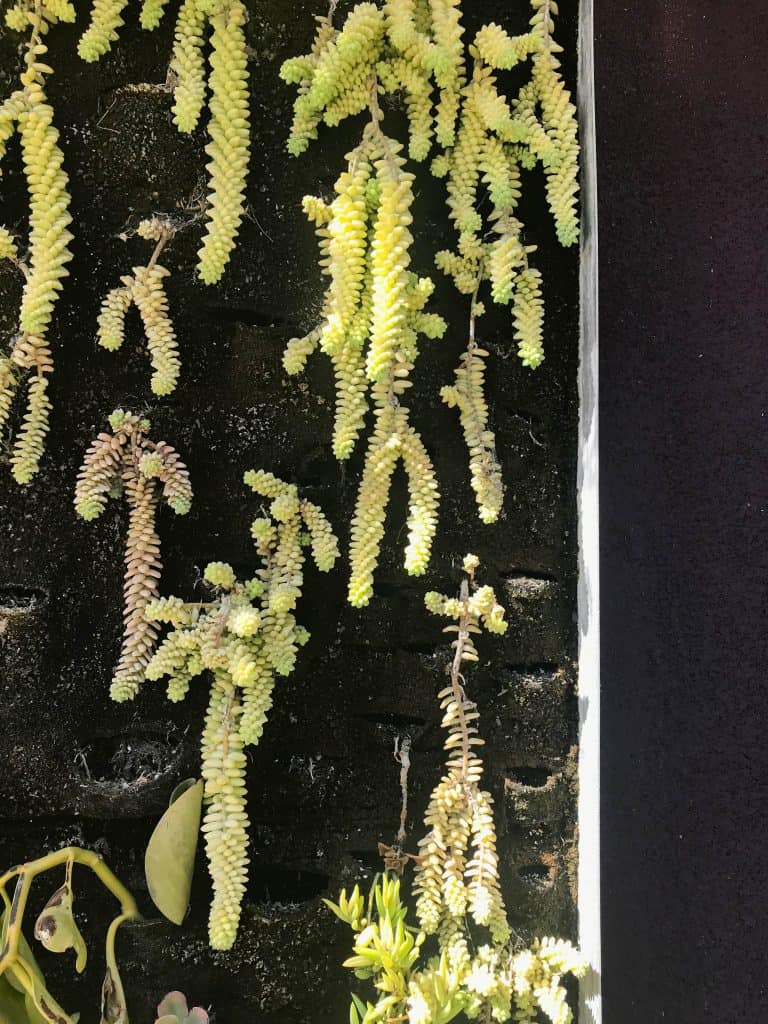
What’s more, I have tried answering all of your most FAQs at the end of the article. So, don’t miss out.
Table of Contents
11 Types of Hanging Succulents
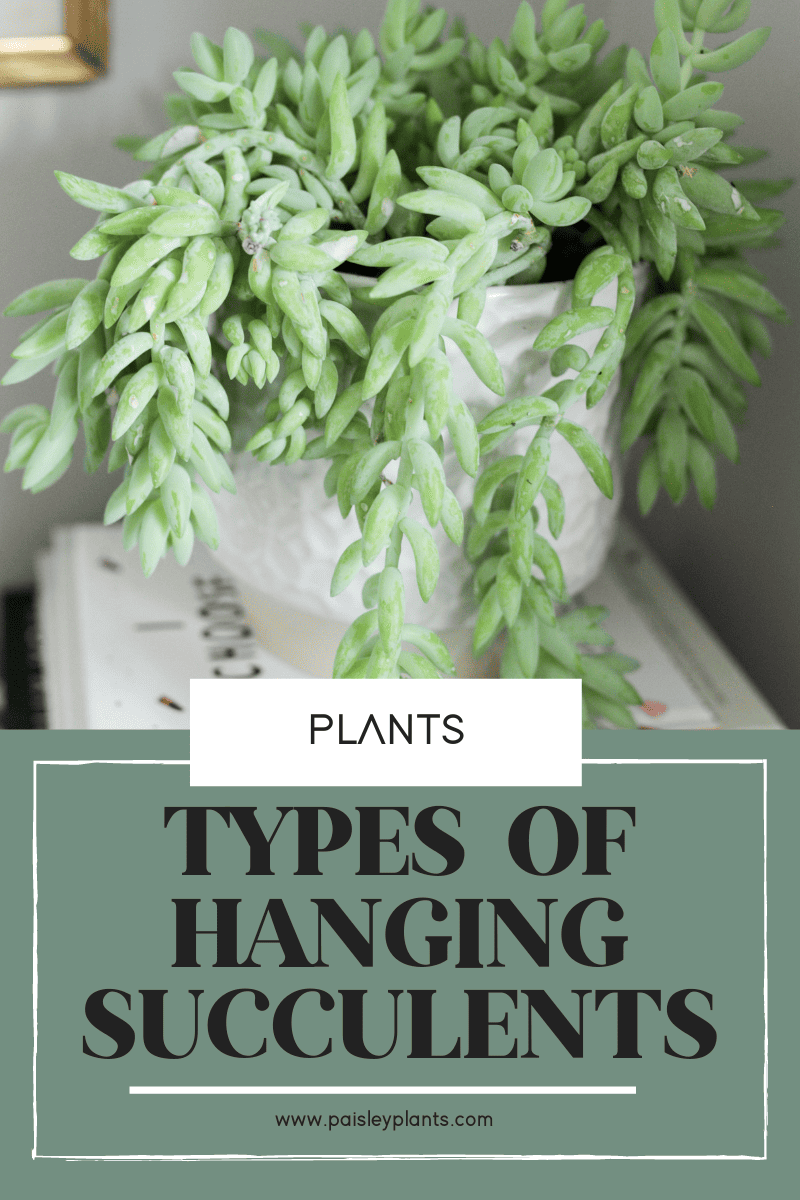
This post includes affiliate links.
Here is a list of top hanging succulents plants.
1. String of Pearls (Curio rowleyanus)
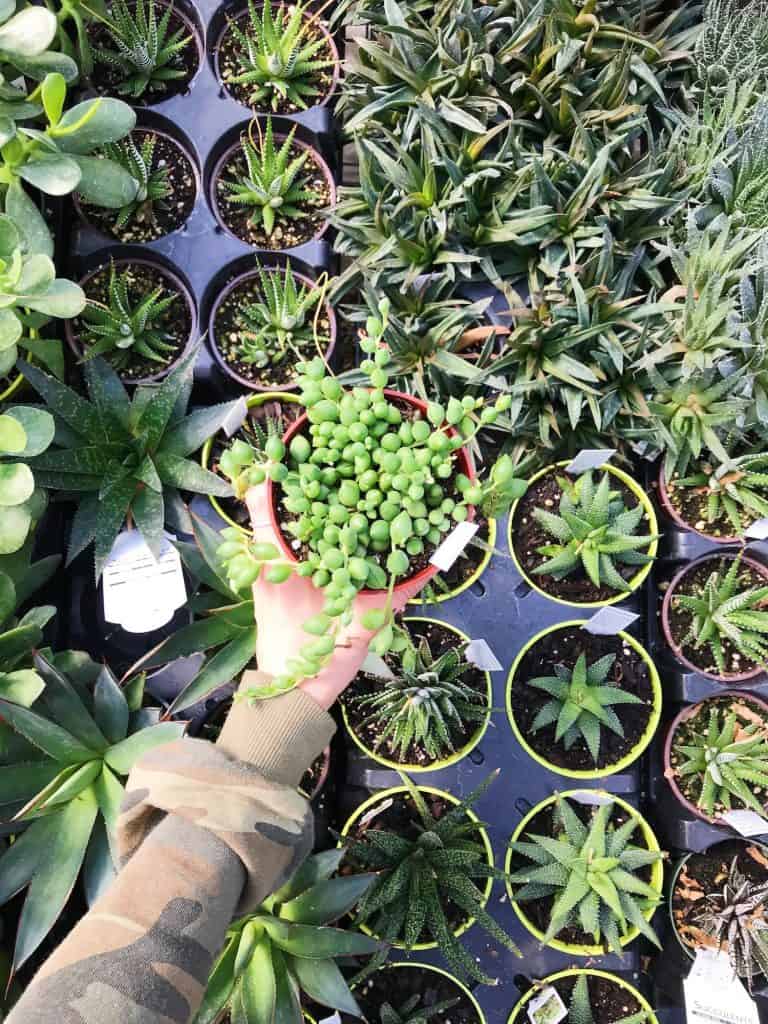
String of Pearls, scientifically known as Senecio Rowleyanus and commonly knows as the String of Beads or the rosary plant, is a super-long trailing plant with its pea-like leaves and stem trailing almost 3 feet.
In ideal conditions, the plant blooms white flowers that smell like vanilla. It’s a perfect choice for hanging baskets to teacups.
Care Tips
What’s surprising is that this drought-tolerant plant is not at all hard to maintain. All you need is a well-drained soil and protection from intense, direct, afternoon sunlight.
Mature String of Pearls needs less water than growing plants. So, water accordingly.
Pro tip: gently squeeze one of the balls – if it’s squishy it means it needs water!
2. String of Fishhooks (Senecio radicans)
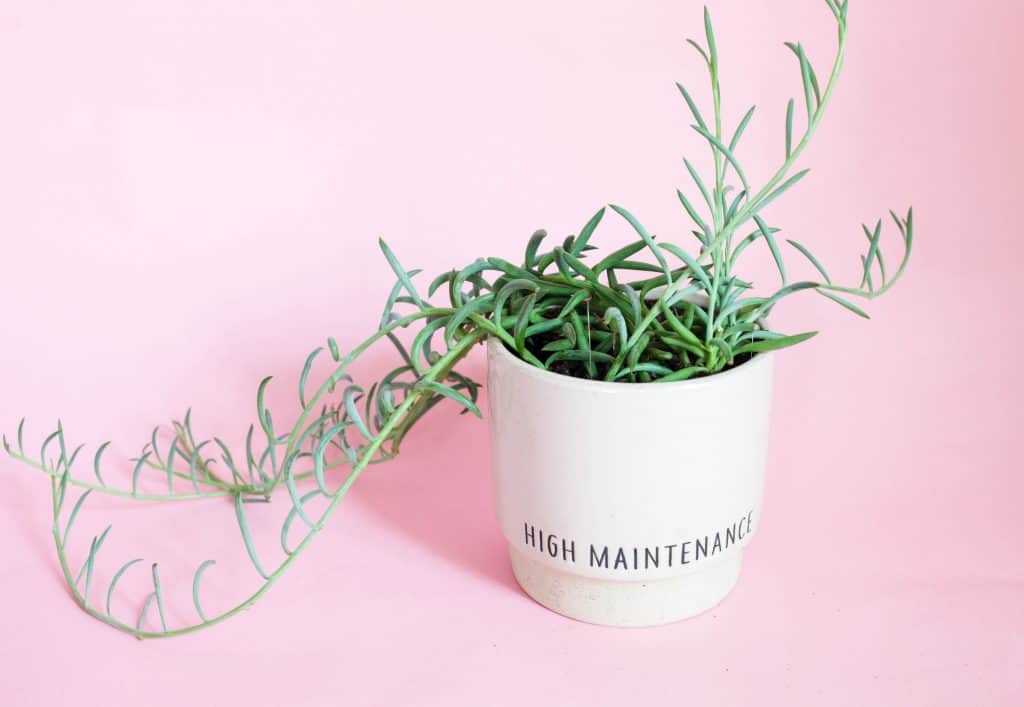
Find this plant at Plants and Me LLC
Looking for an easy to grow, long-trailing plant? Search no more!
String of Fishhooks, aka Senecio Radican, with its long trailing stems and greenish-blue leafage, is as exotic as it gets. This plant mainly grows well in dry soil and mild climate.
Care Tips
Like String of Pearls, this plant also requires a lot of light but needs to be protected from the intense summer sunlight as it may cause the leaves to burn.
Read more String of Fishhooks care tips on this post.
3. String of Bananas (Curio radicans, formerly Senecio radicans)
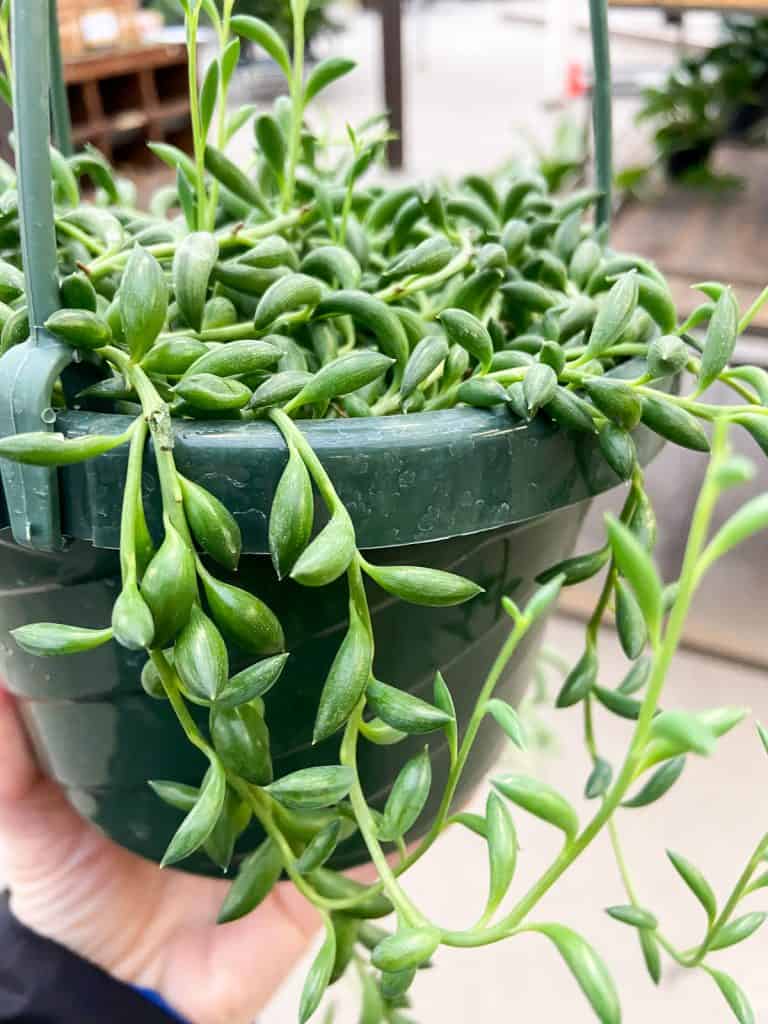
Find this plant at Lily Paradise Flowers
String of Bananas is known for its cascading vines down the office tables. Features such as banana-shaped leaves and its miniature lavender make it a unique breed of plant. The plant produces yellow or white flowers in winter/fall season. It can be grown both indoors & outdoors.
Care Tips
This plant is fairly easy to grow. It does best in a good amount of indirect bright light, but be careful not to place it in full sun as that might cause damage to it’s fleshy leaves and form yellow patches through the foliages.
Check out more String of Bananas care tips here!
READ 7 Best Air Purifying Plants
4. Burro’s Tail Sedum (Sedum morganianum)
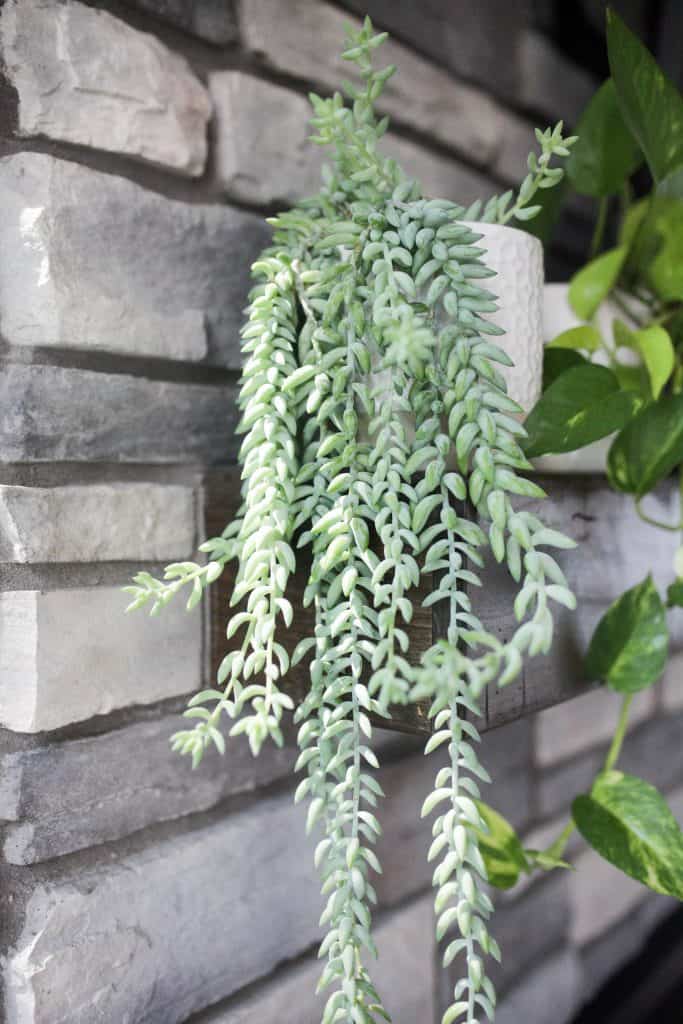
Burro’s Tail Sedum is also known as Senecio morganianum and more famously as Donkey’s Tail.
This plant enjoys being one of the finest and the most popular succulent because of its dew-drop look-alike, silvery-green leaves which adds a refreshing essence to your room.
I have mine hanging over my fireplace mantel and it has grown to incredibly lengths! This one is also super easy to propagate so you can have tons of plants to share.
Care Tips
Burro’s tail is robust in the winter season, but it requires six or more hours of sunlight every day. The plant is drought resistant but you still need to water it sparingly. Nonetheless, make sure the soil is not clogged and water only when the top layer does not hold any moisture.
Love burro’s tails? Check out how to take care of your burro’s tail here.
5. Elephant’s Food/Bush (Portulacaria afra)
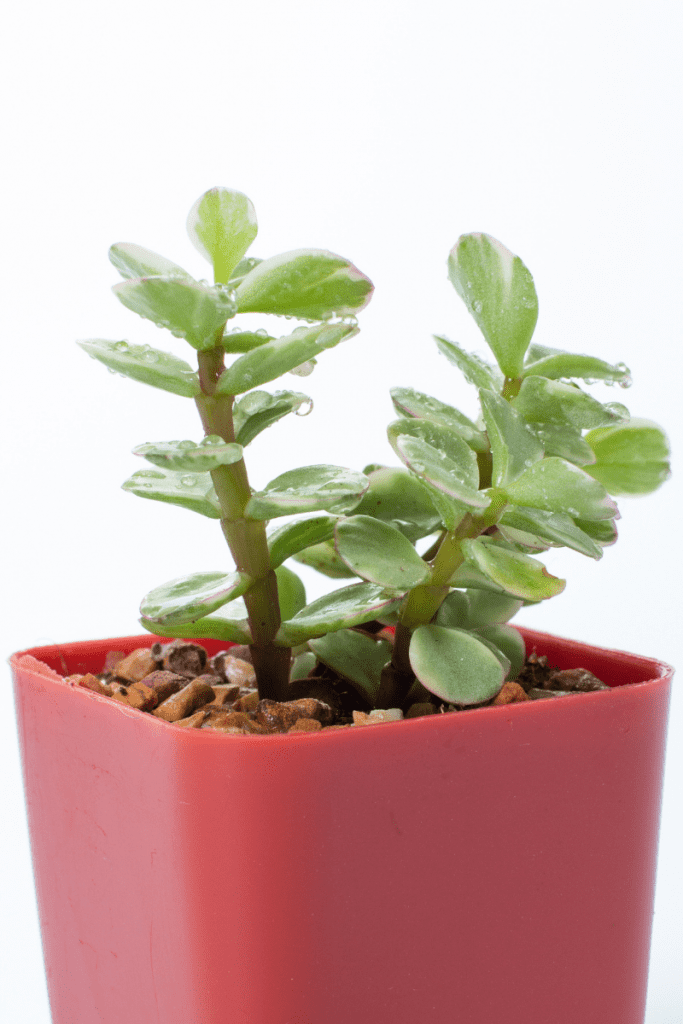
Weird name, right?
Elephant’s bush, scientifically known as Portolacaria Afra, with its thick stem and lustrous leaves, is a tough variety of hanging succulent plants.
Care Tips
Elephant’s Bush is a stunning indoor plant. It has the ability to surprise you with its beautiful variegation but keep it out of direct sunlight as it will cause the leaves to shed. The plant can manage well with an hour of morning sunlight and four to six hours of afternoon indirect sunlight.
*Learn how to care for your Elephant Bush here!
6. Trailing/Hanging Jade (Peperomia rotundifolia)
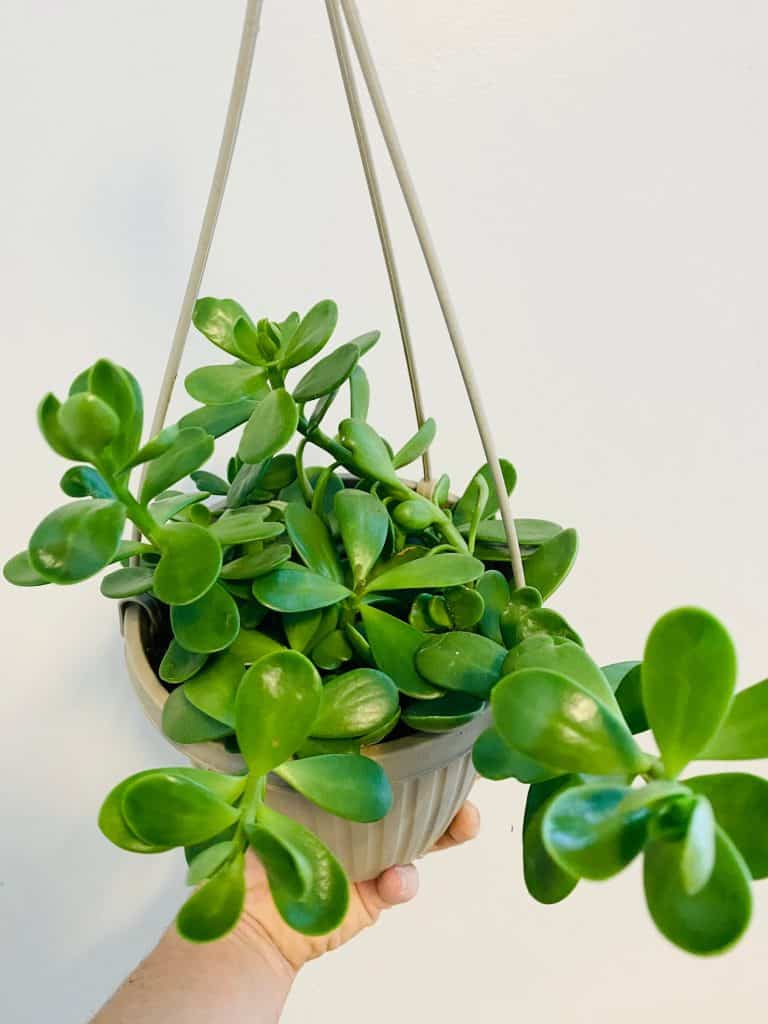
Photo from Brumley and Bloom
The Trailing Jade, also known as Senecio Jacobsenii, can crawl up on you if you don’t watch out. The plant is an amazingly fast grower! It has thick stems and leaves and when left to grow outside, it wastes no time trailing over lawns, pouring over rocks and covering walls.
Care Tips
Trailing Jade optimum condition include a mild warm climate and a lot of indirect sunlight. Water this plant when the top couple inches of soil are dry.
Find how to care for your jade plant here and how to propagate one here!
7. Ruby Necklace (Othonna capensis ‘Ruby Necklace’ )
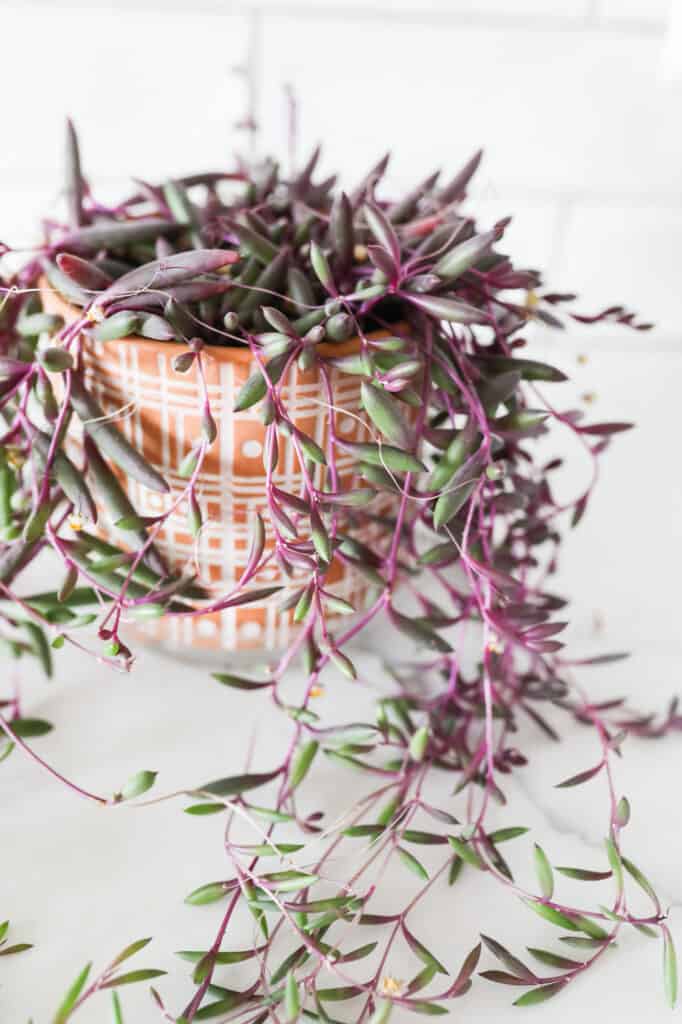
Ruby necklace, also known as Othonna capensis, is easily recognizable by its distinct purple to ruby stems with its exuberant leaves decorated with bright yellow, daisy-like flowers.
The thick leaves are supported by a thin stem, but the leaves don’t fall off as often as that of burro’s tail sedum.
Care Tips
Ruby necklace charm multiplies when placed in bright light. To maintain the exuberance, water the plant every five to seven days in summer and once every three weeks in winter.
Pro-tip: Place it in a larger pot to help the plant reach full potential.
Find Ruby necklace plant care tips here!
8. Air Plant (Tillandsia)
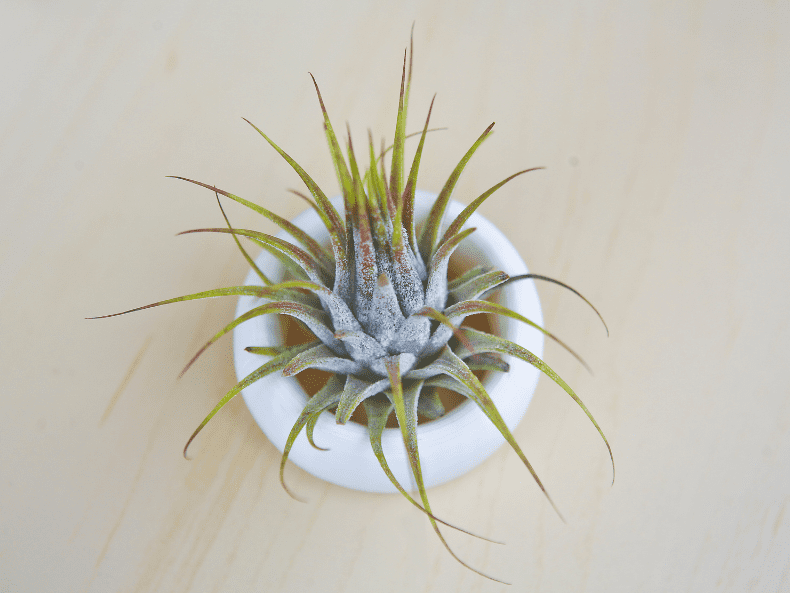
Air Plant is also known as an ‘aerial plant’. The plant is super-easy to maintain as it does not even require a soil to grow in. It is a fantastic, low-maintenance, evergreen edition to your room, balcony and what not.
Care Tips
Air Plants are a popular choice because all you need to do is put it in bright indirect sunlight and soak the plant for up to fifteen minutes in tap-water.
Voila!
The plant will continue to be your companion.
Find air plant growing tips here!
9. Baby Necklace Crassula (Crassula Rupestris)
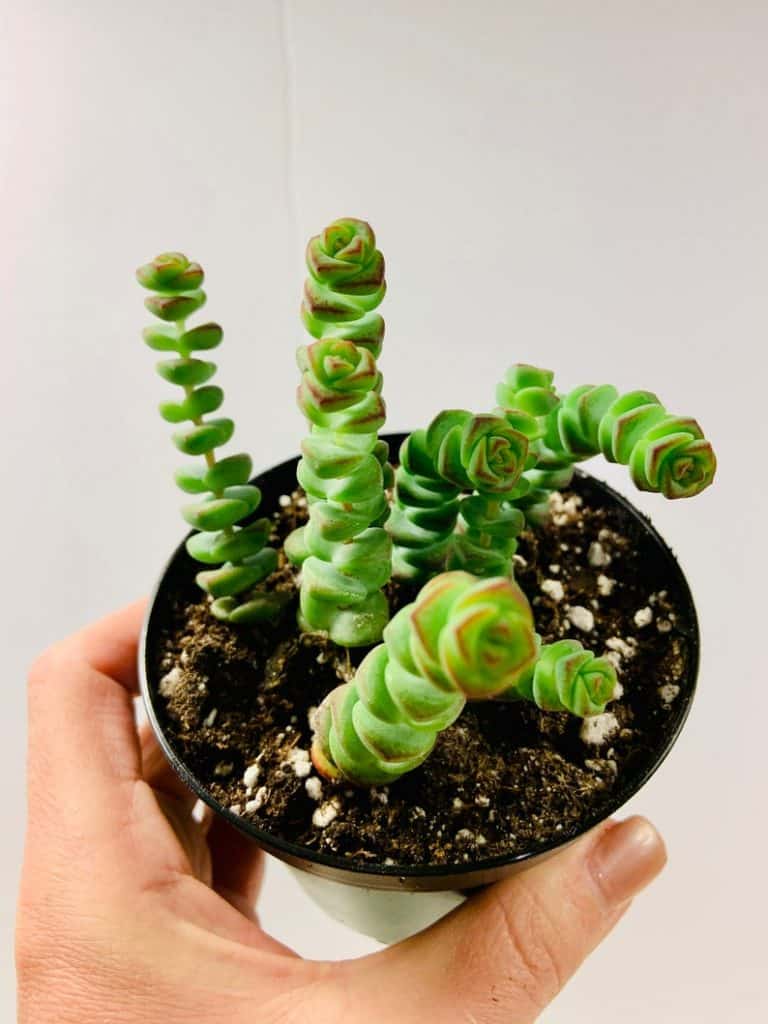
Photo via Soil and Seed Co
Baby Necklace Crassula is a small but charming plant. The plant has unreal cashew-shaped, green leaves that stay mostly upright. In optimal conditions, they’ll produce small, white flowers in late spring or early summer.
Care Tips
The plant will definitely stand out in your collection. Furthermore, it is relatively easy to grow. Watch out though, it is susceptible to fungal diseases and attacks by mealy bugs.
Make sure to not excessively water the plant. You must remove the excess water from the saucer after minutes of watering it.
Read more about how to care for your Crassula here!
10. String of Hearts (Ceropegia woodii)
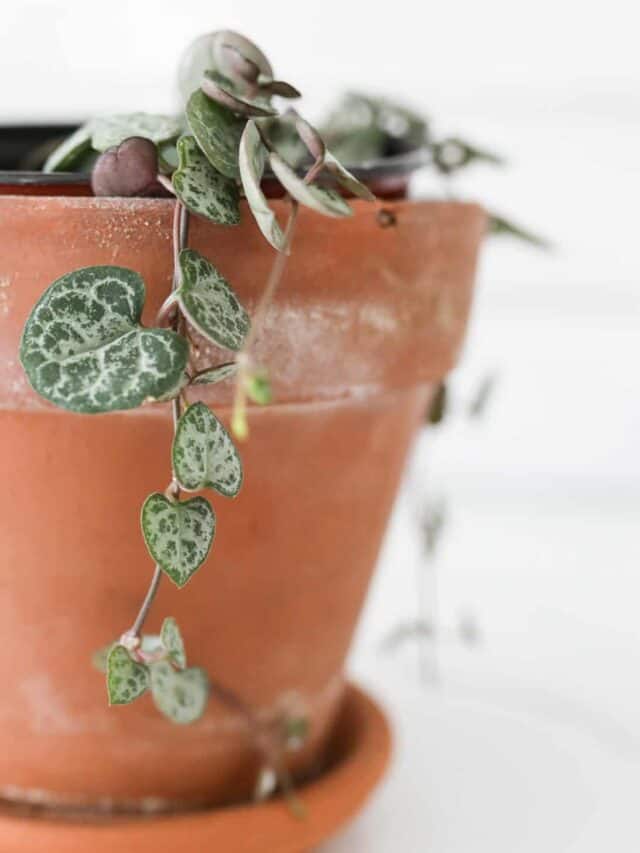
I have a string of hearts hanging in my living room and love it! These plants are incredibly easy to grow even in a pot with no drainage holes!
They’re a perennial plant that’s native to South Africa and characterized the by tiny little heart-shaped leaves that grow on thin, trailing vines.
They can grow super long – up to 12 feet in length but are very easy to propagate to create additional plants.
Care Tips
Ideally put them in a spot with bright indirect light. They love their soil to completely dry out in between watering. Simply stick your finger in the soil to check it before watering!
11. String of Dolphins (Senecio Peregrinus)
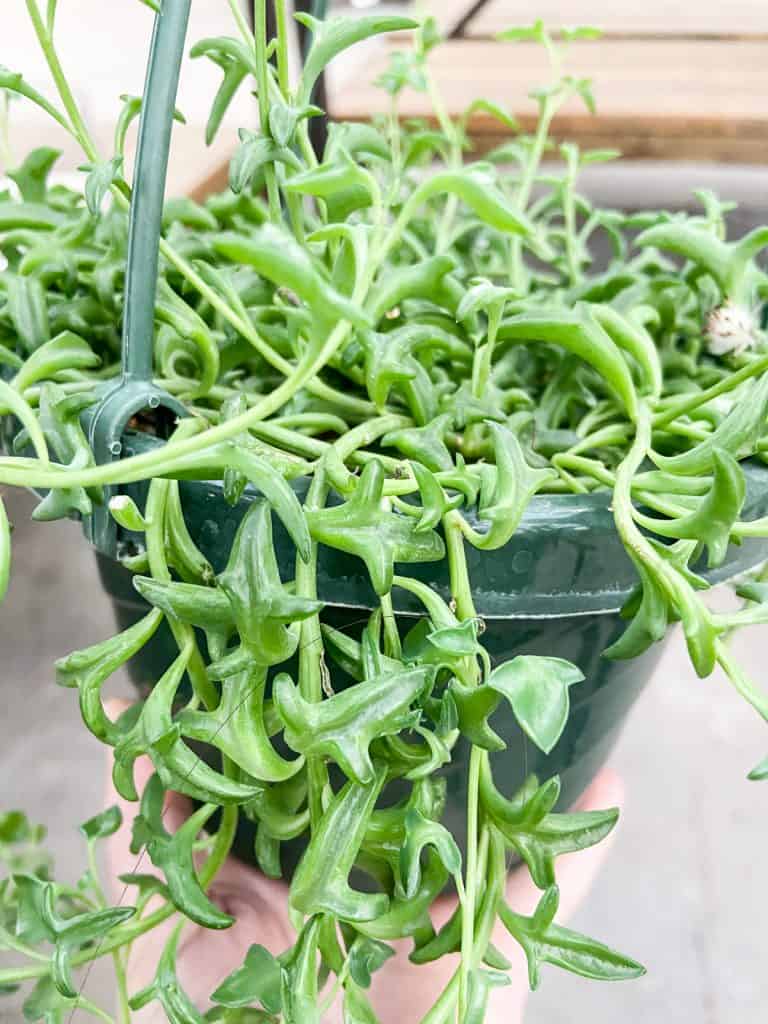
This adorable succulent looks like a sea of dolphins jumping in the air! This plant is a hybrid between the String of Pearls and the Candle Plant (also refered to as the Hot Dog Cactus).
It can grow about 3 feet in length making it a great option for a bit of a shorter hanging succulent than some of the other’s on this list. These plants can bloom (although mine has yet to do so!).
This plant is toxic so be sure to keep it away from kids or pets.
Care Tips
Keep this plant away from direct sun but ensure it gets plenty of indirect light. If the leaves get yellow there’s a good chance it’s getting too much sun!
String of Dolphins can go longer without water so plan on watering it about once every two weeks or whenever the soil is dry to the touch. If the dolphins (or leaves) feel squishy, you know it’s time to water it!
12. Calico Kitten (Crassula Pellucida ‘Variegata’)
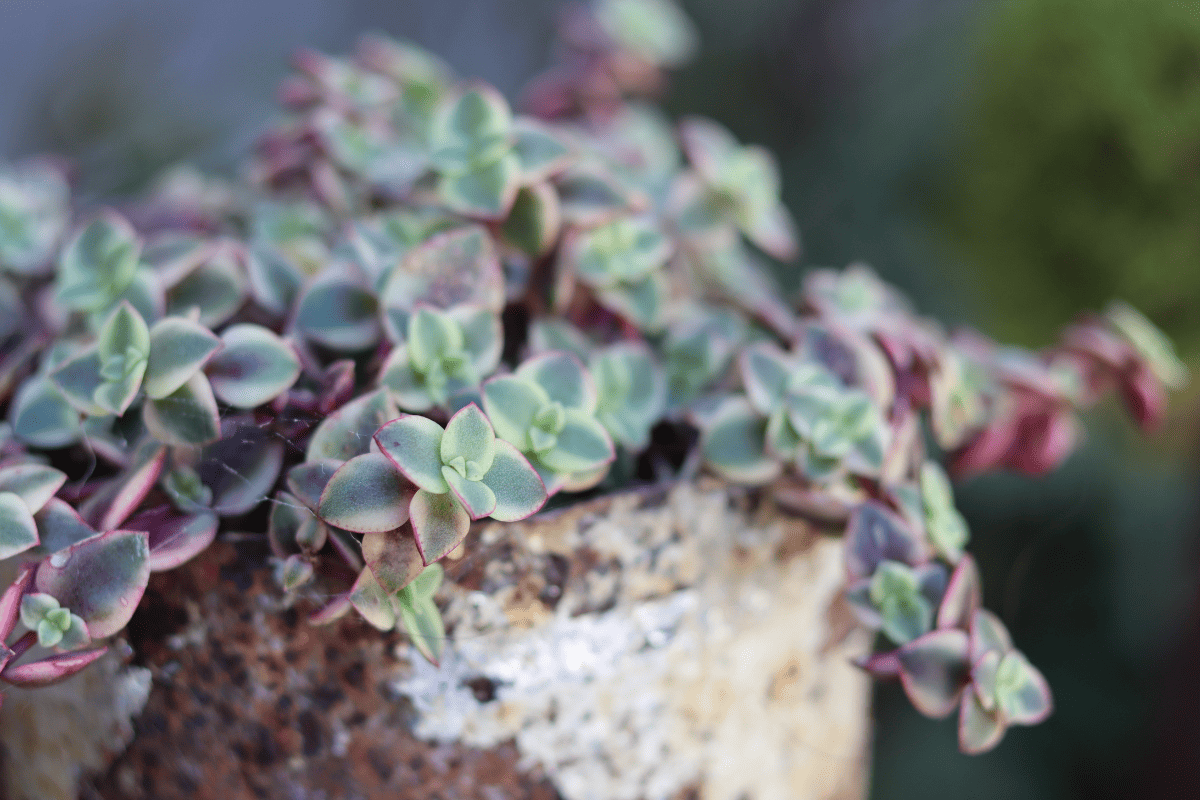
This unique succulent showcases colors of fuschia and purple that can turn into a deep purple when very dry. They are native to South Africa and can be a bit of a tricky plant to grow!
Care Tips
This plant loves a good amount of bright indirect light and can handle some direct light but keep an eye on them so they don’t get burned.
Like most succulents, these do better with under-watering vs over-watering so be sure to only water them when the soil is dry to the touch.
13. Hindu Rope (Hoya Compacta)
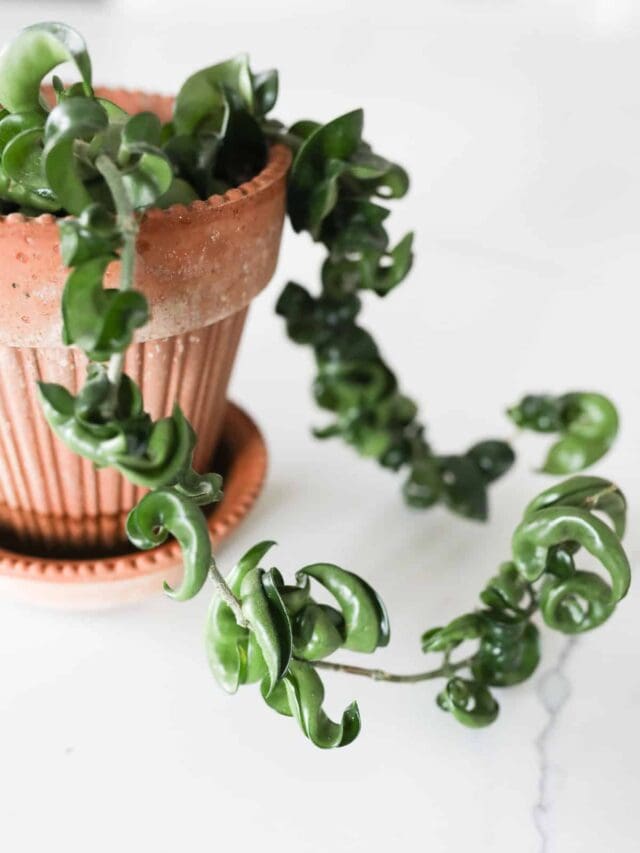
The Hindu Rope Plant (other common name is the Wax Plant) is one of my favorite hoya plants! This one is found in the southern region of Asia; namely India & China.
The features are very similar to that of the classic Hoya carnosa, however the leaves curl around the stem and grow in a vine formation. There are variegated varieties of the compacta which have leaves with pink or white variegations on them.
Care Tips
I find this plant to be very easy to care for! Give it enough bright indirect light (no direct sun please!) and you’ll see it thrive. It can grow in low light but you won’t see much growth and likely no flowers either.
Like the other plants on this list, don’t overwater! Only water it when you’re certain it is dried out. Also be sure it’s in a light, airy soil that has good drainage.
14. Hoya Carnosa
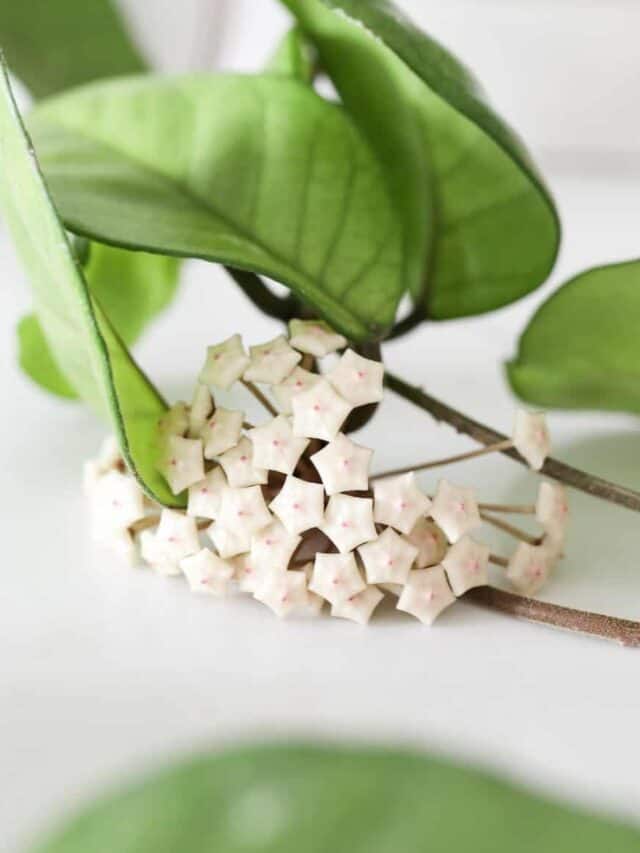
The Hoya Carnosa is another favorite of mine with it’s stunning waxy looking flowers. This plant is native to eastern Asia and Australia.
It’s characterized by large dark green, oval-shaped glossy leaves. It produces flowers that are white/light pink and grow in spherical cluster formations.
Care Tips
These plants love bright indirect light year round. If it doesn’t get enough light it won’t produce flowers. I’ve found success on a north facing windowsill!
Be sure it has enough water (but not too much) during the growing season and cut back a bit in the winter months. In the winter focus on higher humidity levels.
15. String of Nickels (Dischidia nummularia)
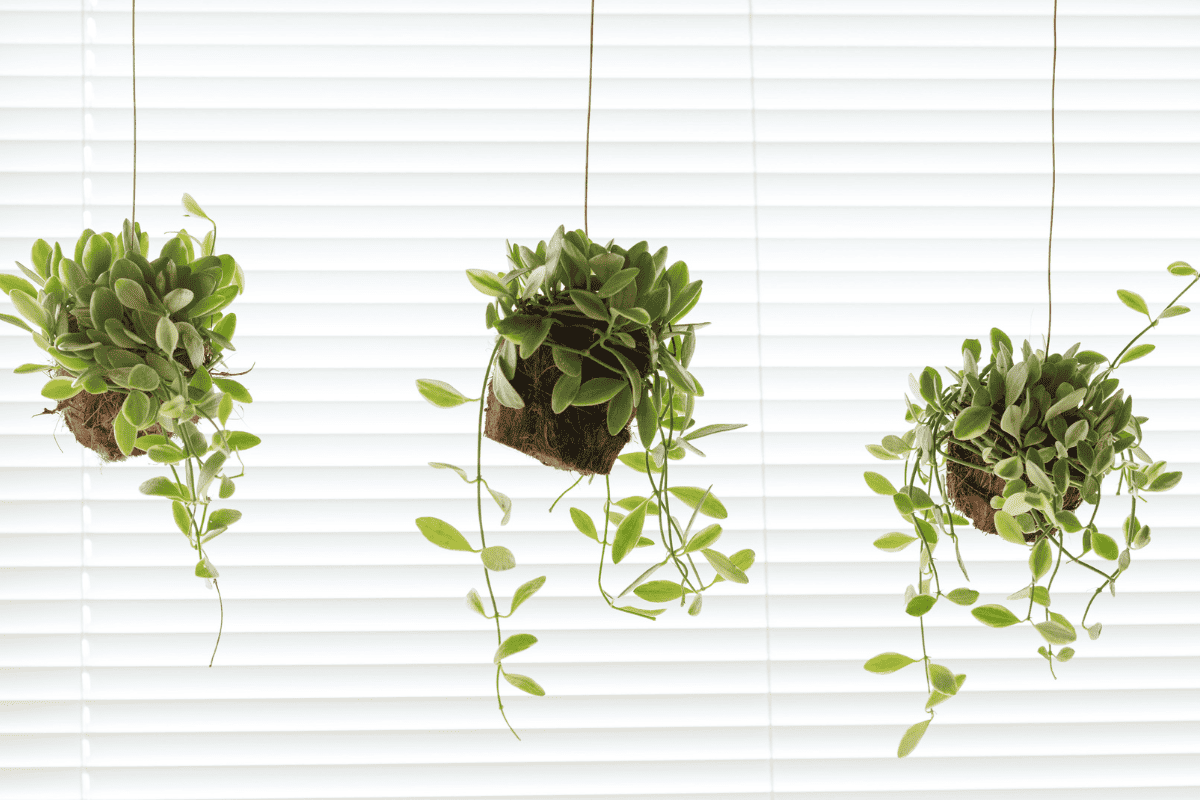
This hanging succulent is native to Asia, India and Australia and can be very difficult to find! It’s a fairly hardy plant that is a type of epiphyte (similar to an air plant).
Care Tips
These are one plant on this list that do well in low light conditions. If it gets a bit of indirect sun that’s great but they can thrive in shady locations.
They don’t do well when root bound so we recommend repotting them every year. Don’t overwater this plant but get in the habit of regular misting which helps the plant absorb moisture.
16. Rat Tail Cactus (Aporocactus Flagelliformis)
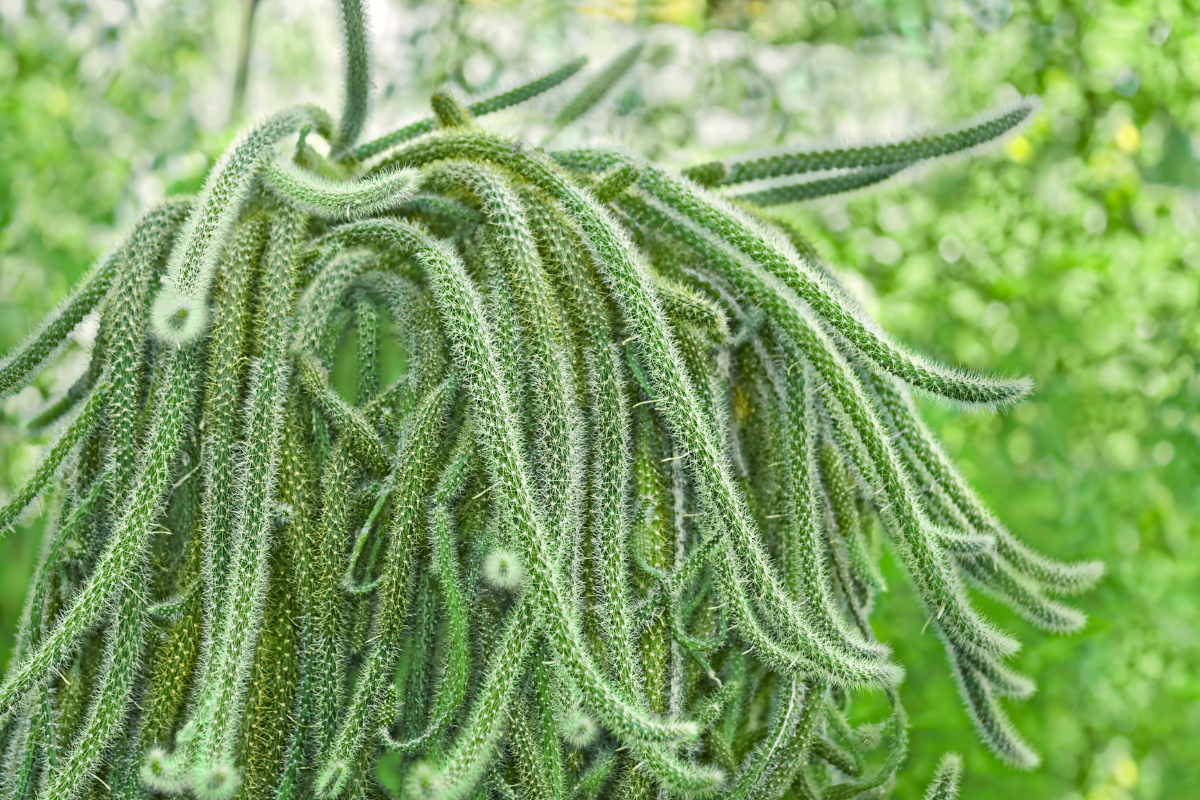
The Rat Tail Cactus is yes, a cactus! Fun fact – all cacti are succulents but not all succulents are cacti.
This plant is native to Mexico and can grow up to 3 feet long. The grow beautiful bright pink or red flowers and their fleshy stems look almost fuzzy to the touch. They’re more or less harmless and not as pokey as other cacti!
Care Tips
The Rat Tail requires bright light in order to grow happy and healthy. Don’t over water and cut back on watering during the dry winter months.
Use a well-draining potting mix for ample drainage.
17. Peanut Cactus (Echinopsis Chamaecereus)
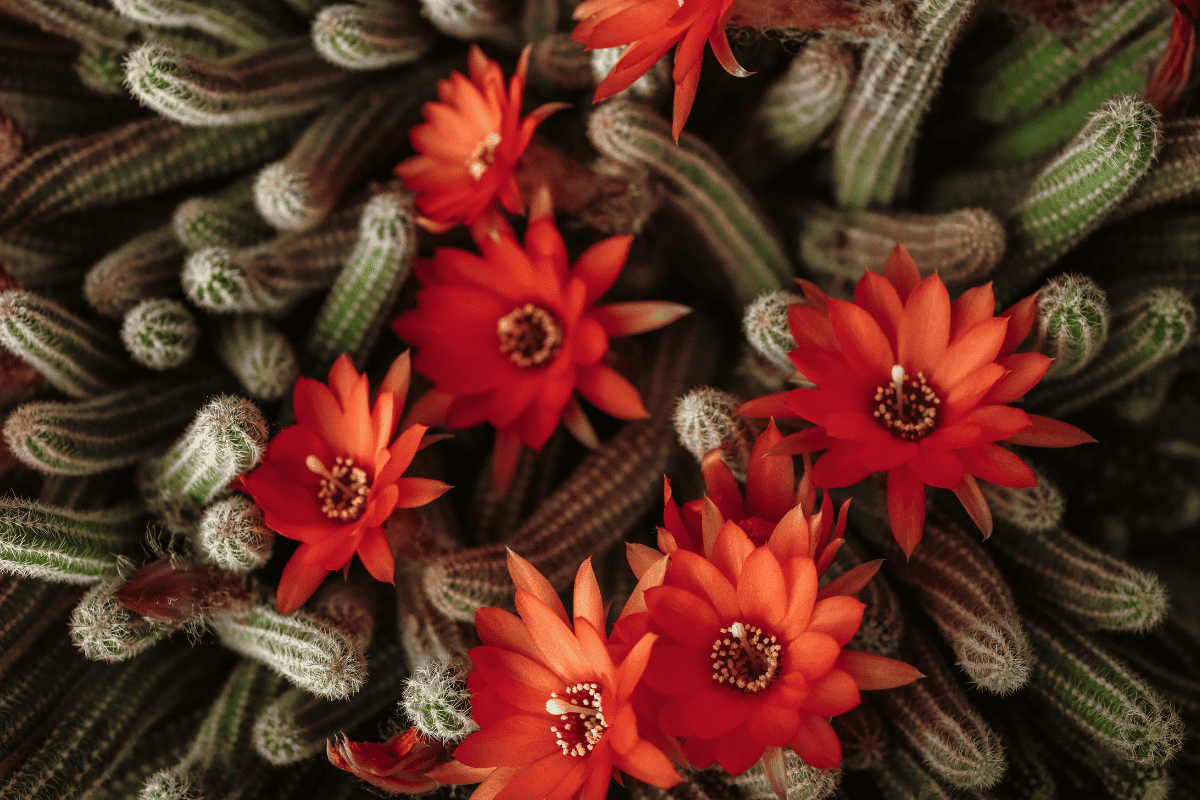
This cactus if very similar to the Rat Tail cactus but these don’t grow quite as long, usually about 6 inches long. Similar to the previous plant they look fuzzy and won’t typically hurt if touched.
These plants are native to Argentina and grow large bright orange-red flowers. Their name comes from the ridges on their stems which reflect a peanut’s shell!
Care Tips
The Peanut Cactus is a pretty low-maintenance cactus that does best in bright sunny conditions. It will not do well in low light conditions.
Like the others, it’s very drought resistance and can go awhile between watering.
More On Caring for Hanging Succulents
Here is a list of general care tips:
- Make sure your plant gets enough sunlight, about six hours per day
- Rotate the succulents frequently, ensure each side of the plant receives sufficient light
- Water about once a week in summer and once every three weeks in winter
- Water the soil directly and use less water if the pot does not have drainage holes
- Be sure to use soil that drains effectively, such as cactus soil
FAQs About Succulent Plants
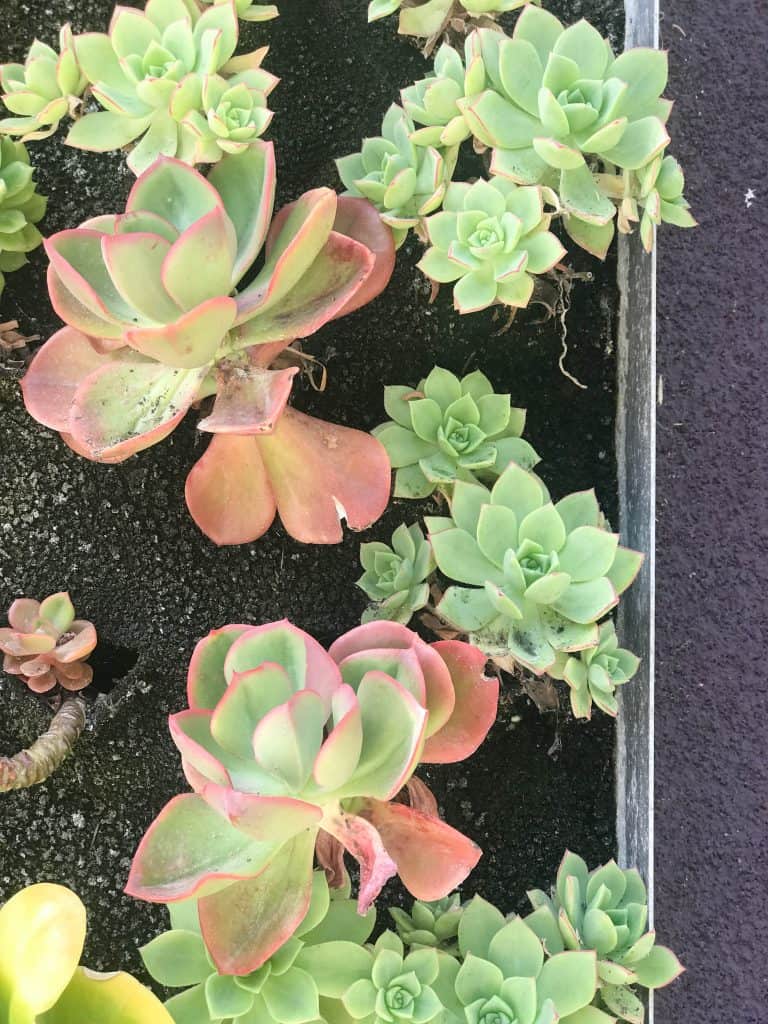
Yes, you can hang succulent plants. Hanging succulents plants are a fantastic investment towards room decor. But make sure you don’t hang the plant in direct sunlight as it will cause the leaves to fall down.
Succulent plants are usually placed in hanging baskets which adds beauty to the trailing stems of the plant. Another infamous but no less aesthetic way is to hang the plant as you would hang a painting. The plant can be hanged naturally on railings as well.
Trailing succulents aka hanging succulents are in nature cascading/forms a stream of stems. You should pot them in a hanging basket to accentuate the cascading effect. You can grow these plants, both indoor and outdoor.
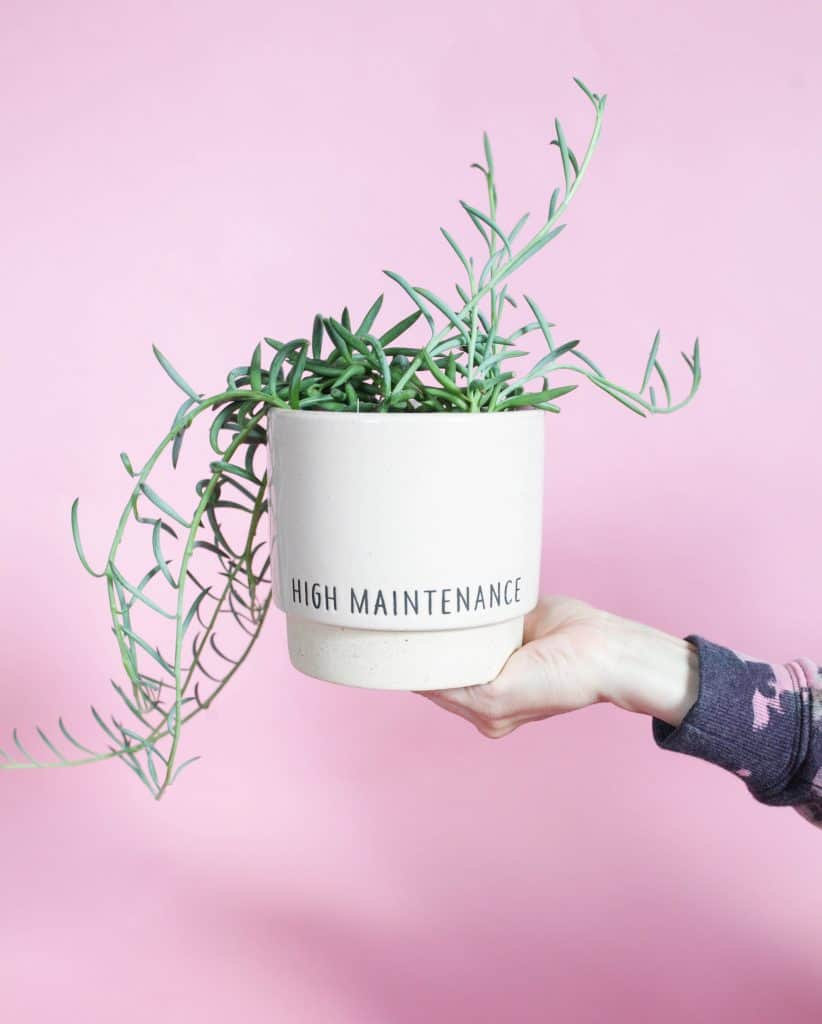
How do you water a succulent hanging?
Disclaimer: Be careful when you water the plant hanging as it may fall and break, hurting you in the process.
Instead of watering the plant, it is better to soak the plant in water and distill off the saucer’s excess water.
But if you choose to water it, water the soil directly and let the excess water pour down through the pot’s drainage holes.
Conclusion
Hanging succulents plants are an easy to grow, low maintenance and a beautiful addition to your room. They do not need pruning often and are a must-have for every plant enthusiast.
If you keep the care tips in mind, you will have no trouble with this plant. Wait no more; get yourself a hanging succulent!
Have a succulent and wondering how to repot it? I have a full post all about how to repot succulents here!

